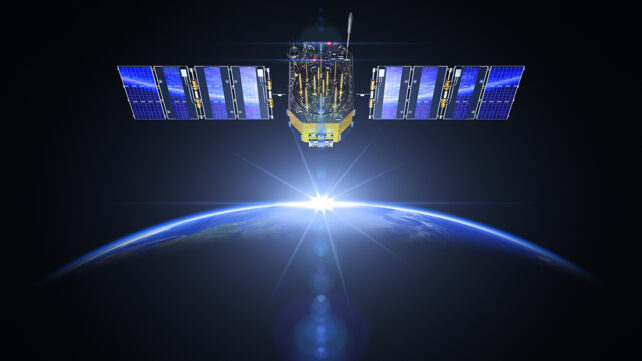Over time, science often turns the impossible into the possible, and the latest example of that is a new study calculating the feasibility of sending quantum signals from Earth to a satellite – with the potential to enable larger, more powerful quantum communication networks.
It's already possible to send entangled particles of light from satellites down to ground stations, but the idea of being able to transfer photons in the other direction – from Earth up to space – had been considered impossible, due to difficulties keeping the signal stable.
This latest study, from a team at the University of Technology Sydney (UTS) in Australia, suggests it could be done. It's based on a detailed model that deploys entanglement swapping, taking into account probable atmospheric conditions, satellite positioning, and interference from stray photons and noise.
Related: Alien Phone Calls Could Be Quantum, And We're Not Ready to Hear Them
"The idea is to fire two single particles of light from separate ground stations to a satellite orbiting 500 kilometers (310 miles) above Earth, traveling at about 20,000 kilometers per hour, so that they meet so perfectly as to undergo quantum interference," says UTS physicist Simon Devitt.
"Surprisingly, our modeling showed that an uplink is feasible. We included real-world effects such as background light from the Earth and sunlight reflections from the Moon, atmospheric effects and the imperfect alignment of optical systems."

So why does it matter? A quantum internet promises networks that are unhackable by design: As soon as unauthorized parties even look at the data, it gets scrambled. Entangled particles like photons are used to verify communications at each end.
Today, these secret keys can be created on satellites and then beamed to the ground. It's easier to keep photons stable in a downward direction, because atmospheric scattering happens at the end of transmission, not the start. Plus, it's easier to hit larger, more fixed targets on the ground than a roving satellite in space.
The big drawback is power: satellites don't have much of it. Ground stations, however, do. Performing the more demanding tasks on the ground means a lot more entangled pairs of photons can be produced more quickly, then beamed to satellites for further distribution.
"The satellite only needs a compact optical unit to interfere incoming photons and report the result," says Devitt, "rather than quantum hardware to produce the trillions upon trillions of photons per second needed to overcome losses to the ground, allowing for a high-bandwidth quantum link. That keeps costs and size down and makes the approach more practical."
There are some caveats here. While the system could technically work to a high level of fidelity (which ensures data reliability), it could only function at night, away from the interference of sunlight – and even then only with careful calibration. But it's something to build on.
A fully working quantum communications network is still quite a way off, but now we know that two-way systems are at least theoretically possible. Future real-world tests could be carried out using receivers on drones or balloons, the researchers suggest.
"In the future, quantum entanglement is going to be a bit like electricity: a commodity that we talk about that powers other things," says Devitt.
"It's generated and transmitted in a way that is often invisible to the user – we just plug in our appliances and use it."
The research has been published in Physical Review Research.

